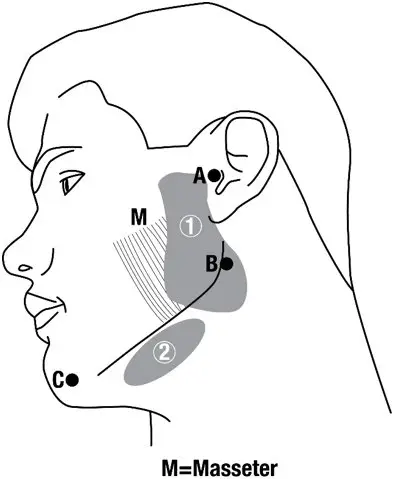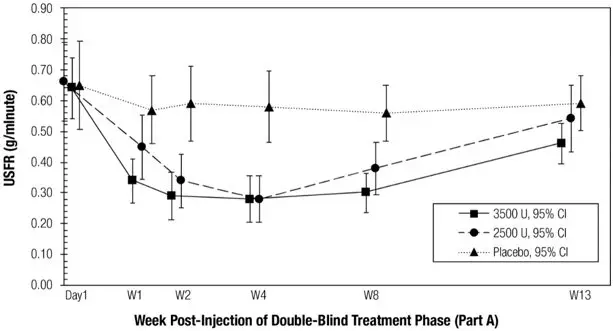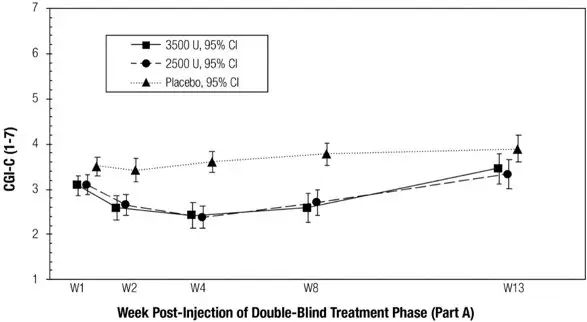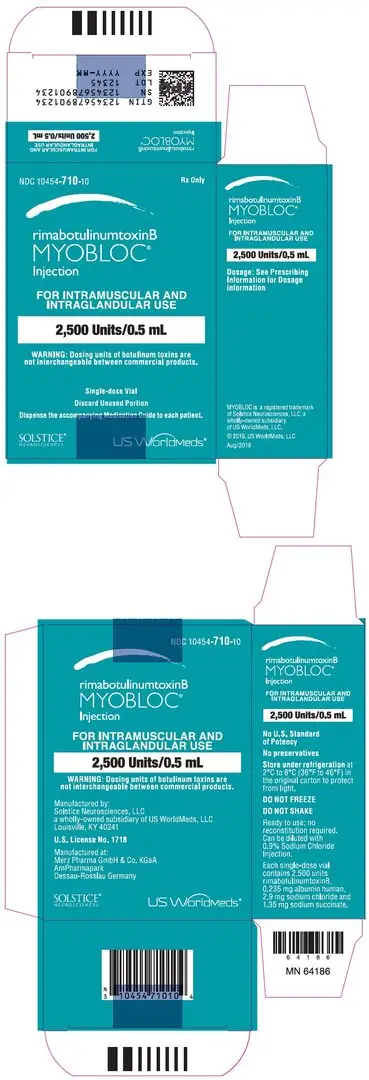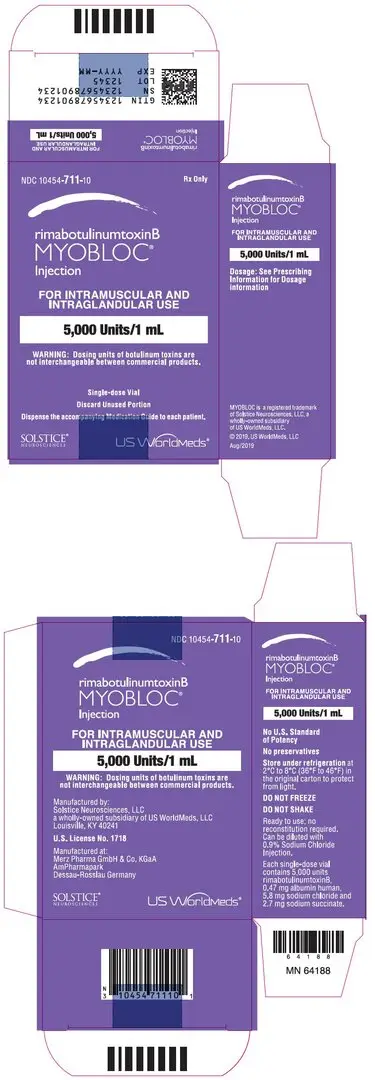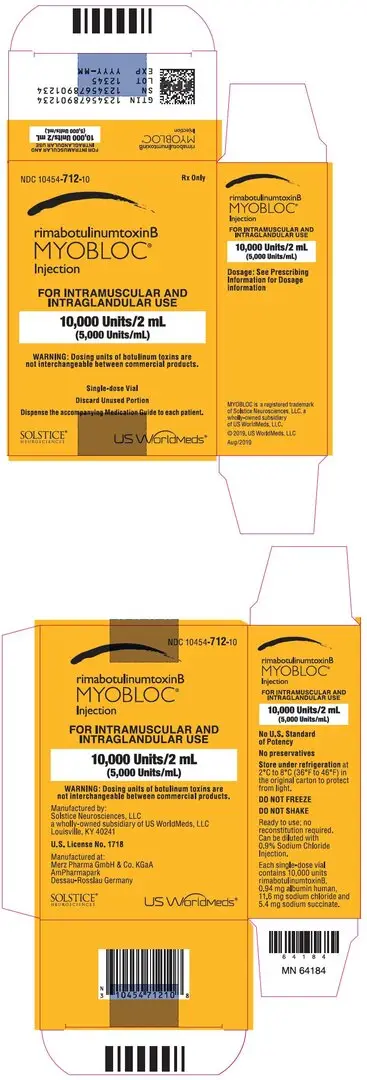Drug Detail:Myobloc (Rimabotulinumtoxinb (myobloc) [ rye-ma-bot-ue-lye-num-tox-in-b ])
Drug Class: Skeletal muscle relaxants
Highlights of Prescribing Information
MYOBLOC ® (rimabotulinumtoxinB) injection, for intramuscular or intraglandular use
Initial U.S. Approval: 2000
WARNING: DISTANT SPREAD OF TOXIN EFFECT
See full prescribing information for complete boxed warning.
The effects of MYOBLOC and all botulinum toxin products may spread from the area of injection to produce symptoms consistent with botulinum toxin effects. These symptoms have been reported hours to weeks after injection. Swallowing and breathing difficulties can be life threatening and there have been reports of death. The risk of symptoms is probably greatest in children treated for spasticity but symptoms can also occur in adults, particularly in those patients who have an underlying condition that would predispose them to these symptoms ( 5.1).
Indications and Usage for Myobloc
MYOBLOC is an acetylcholine release inhibitor indicated for:
- Treatment of cervical dystonia to reduce the severity of abnormal head position and neck pain associated with cervical dystonia in adults ( 1.1)
- Treatment of chronic sialorrhea in adults ( 1.2)
Myobloc Dosage and Administration
- Cervical Dystonia: for patients with demonstrated tolerance of botulinum toxin injection, recommended total dosage is 2,500 Units to 5,000 Units divided among effected muscles ( 2.2)
- Chronic Sialorrhea: recommended dosage is 1,500 Units to 3,500 Units; 500 Units to 1,500 Units per parotid gland and 250 Units per submandibular gland; no more frequent than every 12 weeks ( 2.3)
Dosage Forms and Strengths
Injection: 2,500 Units/0.5 mL; 5,000 Units/mL; or 10,000 Units/2 mL (5,000 Units/mL) in a single-dose vial ( 3)
Contraindications
MYOBLOC is contraindicated in patients with:
- Known hypersensitivity to any botulinum toxin preparation or to any of the components in the formulation ( 4, 5.3)
- Infection at the proposed injection site(s) ( 4)
Warnings and Precautions
- Spread of toxin effects; swallowing and breathing difficulties can lead to death. Seek immediate medical attention if respiratory, speech or swallowing difficulties occur ( 5.1, 5.4)
- MYOBLOC potency units cannot be compared to or converted into units of other botulinum toxins ( 5.2)
- Patients with neuromuscular disorders should be monitored closely for swallowing/breathing difficulty ( 5.4)
Adverse Reactions/Side Effects
The most common adverse reactions (>5% of MYOBLOC-treated patients at any dose and >5% more common than placebo) include:
- Cervical Dystonia: dry mouth, dysphagia, injection site pain, and headache ( 6.1)
- Chronic Sialorrhea: dry mouth and dysphagia ( 6.1)
To report SUSPECTED ADVERSE REACTIONS, contact Solstice Neurosciences at 1-888-461-2255 or FDA at 1-800-FDA-1088 or www.fda.gov/medwatch.
Drug Interactions
- Co-administration with aminoglycosides or other agents interfering with neuromuscular transmission may potentiate effects of MYOBLOC ( 7.1)
- Co-administration or overlapping of botulinum toxin serotypes (within 4 months) may potentiate neuromuscular paralysis ( 7.3)
See 17 for PATIENT COUNSELING INFORMATION and Medication Guide.
Revised: 3/2021
Related/similar drugs
Botox, onabotulinumtoxinA, Dysport, Daxxify, Xeomin, abobotulinumtoxinA, rimabotulinumtoxinBFull Prescribing Information
WARNING: DISTANT SPREAD OF TOXIN EFFECT
Postmarketing reports indicate that the effects of MYOBLOC and all botulinum toxin products may spread from the area of injection to produce symptoms consistent with botulinum toxin effects. These may include asthenia, generalized muscle weakness, diplopia, blurred vision, ptosis, dysphagia, dysphonia, dysarthria, urinary incontinence, and breathing difficulties. These symptoms have been reported hours to weeks after injection. Swallowing and breathing difficulties can be life threatening and there have been reports of death. The risk of symptoms is probably greatest in children treated for spasticity but symptoms can also occur in adults treated for spasticity and other conditions, particularly in those patients who have underlying conditions that would predispose them to these symptoms. In unapproved uses, including spasticity in children and adults, and in approved indications, cases of spread of effect have occurred at doses comparable to those used to treat cervical dystonia and at lower doses [see Warnings and Precautions (5.1)].
1. Indications and Usage for Myobloc
2. Myobloc Dosage and Administration
2.1 Instructions for Safe Use
The potency units of MYOBLOC are specific to the preparation and assay method utilized. They are not interchangeable with other preparations of botulinum toxin products and cannot be compared to or converted into units of any other botulinum toxin products [see Warnings and Precautions (5.2), Description (11)] .
Each single-dose vial should only be used during one session and only for one patient. Discard any remaining solution in the vial.
MYOBLOC is ready to use; no reconstitution required.
MYOBLOC may be diluted with 0.9% Sodium Chloride Injection. Once diluted, the product must be used within 4 hours as the formulation does not contain a preservative.
2.2 Dosing for Cervical Dystonia
The recommended initial dosage of MYOBLOC for cervical dystonia patients with a prior history of tolerating botulinum toxin injections is 2,500 Units to 5,000 Units divided among affected muscles [see Clinical Studies (14.1)] . Patients without a prior history of tolerating botulinum toxin injections should receive a lower initial dosage [see Adverse Reactions (6.1)] . Subsequent dosing should be determined by the patient's individual response. MYOBLOC should be administered by physicians familiar with and experienced in the assessment and management of patients with cervical dystonia.
The duration of effect in patients responding to MYOBLOC treatment for cervical dystonia has been observed in studies to be between 12 and 16 weeks at doses of 5,000 Units or 10,000 Units [see Clinical Studies (14.1)] .
3. Dosage Forms and Strengths
MYOBLOC is a clear and colorless to light-yellow solution available as:
- Injection: 2,500 Units/0.5 mL in a single-dose vial
- Injection: 5,000 Units/mL in a single-dose vial
- Injection: 10,000 Units/2 mL (5,000 Units/mL) in a single-dose vial
4. Contraindications
MYOBLOC is contraindicated in patients with:
- A known hypersensitivity to any botulinum toxin product or to any of the components in the formulation [see Warnings and Precautions (5.3), Description (11)]
- Infection at the proposed injection site(s)
5. Warnings and Precautions
5.1 Spread of Toxin Effect
Postmarketing safety data from MYOBLOC and other approved botulinum toxins suggest that botulinum toxin effects may, in some cases, be observed beyond the site of local injection. The symptoms are consistent with the mechanism of action of botulinum toxin and may include asthenia, generalized muscle weakness, diplopia, blurred vision, ptosis, dysphagia, dysphonia, dysarthria, urinary incontinence, and breathing difficulties. These symptoms have been reported hours to weeks after injection. Swallowing and breathing difficulties can be life threatening and there have been reports of death related to spread of toxin effects. The risk of symptoms is probably greatest in children treated for spasticity, but symptoms can also occur in adults treated for spasticity and other conditions, and particularly in those patients who have underlying conditions that would predispose them to these symptoms. In unapproved uses, including spasticity in children and adults, and in approved indications, symptoms consistent with spread of toxin effect have been reported at doses comparable to or lower than doses used to treat cervical dystonia.
5.2 Lack of Interchangeability between Botulinum Toxin Products
The potency units of MYOBLOC are specific to the preparation and biological activity assay method utilized. Due to differences in the aspects of this assay such as the vehicle, dilution scheme, and laboratory protocols for various potency assays, potency units are not interchangeable with other preparations of botulinum toxin products and, therefore, units of biological activity of MYOBLOC cannot be compared to or converted into units of any other botulinum toxin products assessed with any other specific assay method [see Description (11)] .
5.3 Hypersensitivity Reactions
Serious hypersensitivity reactions have been reported with botulinum toxin products. Angioedema, urticaria, and rash have occurred with MYOBLOC treatment [see Adverse Reactions (6.3)]. Hypersensitivity reactions can also include anaphylaxis, serum sickness, soft tissue edema, and dyspnea. If serious and/or immediate hypersensitivity reactions occur, discontinue further injection of MYOBLOC and institute appropriate medical therapy immediately. The use of MYOBLOC in patients with a known hypersensitivity to any botulinum neurotoxin or to any of the excipients (human albumin, sucrose), could lead to a life-threatening allergic reaction [see Contraindications (4), Adverse Reactions (6.3)].
5.4 Dysphagia and Breathing Difficulties
Treatment with MYOBLOC and other botulinum toxin products can result in swallowing or breathing difficulties. Patients with pre-existing swallowing or breathing difficulties may be more susceptible to these complications. In most cases, this is a consequence of weakening of muscles in the area of injection that are involved in breathing or swallowing. When distant effects occur, additional respiratory muscles may be involved.
Deaths as a complication of severe dysphagia have been reported after treatment with botulinum toxin. Dysphagia may persist for several months and require use of a feeding tube to maintain adequate nutrition and hydration. Aspiration may result from severe dysphagia and is a particular risk when treating patients in whom swallowing or respiratory function is already compromised.
Treatment of cervical dystonia with botulinum toxins may weaken neck muscles that serve as accessory muscles of ventilation. This may result in a critical loss of breathing capacity in patients with respiratory disorders who may have become dependent upon these accessory muscles. There have been postmarketing reports of serious breathing difficulties, including respiratory failure, in cervical dystonia patients. Patients treated with botulinum toxin may require immediate medical attention should they develop problems with swallowing, speech or respiratory disorders. These reactions can occur within hours to weeks after injection with botulinum toxin [see Adverse Reactions (6.1)] .
Individuals with peripheral motor neuropathic diseases, amyotrophic lateral sclerosis, or neuromuscular junctional disorders (e.g., myasthenia gravis or Lambert-Eaton syndrome) should be monitored particularly closely when given botulinum toxin. Patients with neuromuscular disorders may be at increased risk of clinically significant effects including severe dysphagia and respiratory compromise from typical doses of MYOBLOC [see Adverse Reactions (6.1)] .
5.5 Human Albumin and Transmission of Viral Diseases
This product contains albumin, a derivative of human blood. Based on effective donor screening and product manufacturing processes, it carries an extremely remote risk for transmission of viral diseases and variant Creutzfeldt-Jakob disease (vCJD). There is a theoretical risk for transmission of Creutzfeldt-Jakob disease (CJD), but if that risk actually exists, the risk of transmission would be considered extremely remote. No cases of transmission of viral diseases, CJD, or vCJD have ever been identified for licensed albumin or albumin contained in other licensed products.
6. Adverse Reactions/Side Effects
The following clinically significant adverse reactions to MYOBLOC are discussed in greater detail in other sections of the labeling:
- Spread of Toxin Effect [see Warnings and Precautions (5.1)]
- Lack of Interchangeability Between Botulinum Toxin Products [see Warnings and Precautions (5.2)]
- Hypersensitivity Reactions [see Warnings and Precautions (5.3)]
- Dysphagia and Breathing Difficulties [see Warnings and Precautions (5.4)]
- Human Albumin and Transmission of Viral Diseases [see Warnings and Precautions (5.5)]
6.1 Clinical Trials Experience
Because clinical trials are conducted under widely varying conditions, adverse reaction rates observed in the clinical trials of a drug cannot be directly compared to rates in clinical trials of another drug and may not reflect the rates observed in practice.
6.2 Immunogenicity
As with all therapeutic proteins, there is potential for immunogenicity. The detection of antibody formation is highly dependent on the sensitivity and specificity of the assay. Additionally, the observed incidence of antibody (including neutralizing antibody) positivity in an assay may be influenced by several factors, including assay methodology, sample handling, timing of sample collection, concomitant medications, and underlying disease. For these reasons, comparison of the incidence of antibodies in the studies described below with the incidence of antibodies in other studies or to other rimabotulinumtoxinB products may be misleading.
6.3 Postmarketing Experience
The following adverse reactions have been reported during postmarketing use of MYOBLOC: angioedema, urticaria, rash, constipation, dry eye, and accommodation disorder. Because these reactions are reported voluntarily from a population of uncertain size, it is not always possible to reliably estimate their frequency or establish a causal relationship to drug exposure.
7. Drug Interactions
7.1 Aminoglycosides and Other Agents Interfering with Neuromuscular Transmission
Co-administration of MYOBLOC and aminoglycosides or other agents interfering with neuromuscular transmission (e.g., curare-like compounds) should only be performed with caution as the effect of the toxin may be potentiated.
7.2 Anticholinergic Drugs
Use of anticholinergic drugs after administration of MYOBLOC may potentiate systemic anticholinergic effects.
7.3 Other Botulinum Neurotoxin Products
The effect of administering different botulinum toxin products at the same time or within several months of each other is unknown. Excessive neuromuscular weakness may be exacerbated by administration of another botulinum toxin prior to the resolution of the effects of a previously administered botulinum toxin.
10. Overdosage
Excessive doses of MYOBLOC may be expected to produce neuromuscular weakness with a variety of symptoms. Respiratory support may be required where excessive doses cause paralysis of respiratory muscles. In the event of overdose, the patient should be medically monitored for symptoms of excessive muscle weakness or muscle paralysis [see Warnings and Precautions (5.1, 5.4)] . Symptomatic treatment may be necessary.
Symptoms of overdose are likely not to be present immediately following injection. Should accidental injection or oral ingestion occur, the person should be medically supervised for several weeks for signs and symptoms of excessive muscle weakness or muscle paralysis.
In the event of overdose, antitoxin raised against botulinum toxin is available from the Centers for Disease Control and Prevention (CDC) in Atlanta, GA. However, the antitoxin will not reverse any botulinum toxin-induced effects already apparent by the time of antitoxin administration. In the event of suspected or actual cases of botulinum toxin poisoning, please contact your local or state Health Department to process a request for antitoxin through the CDC. If you do not receive a response within 30 minutes, please contact the CDC directly at 770-488-7100. More information can be obtained at http://cdc.gov/ncidod/srp/drugs/drug-service.html.
11. Myobloc Description
RimabotulinumtoxinB is an acetylcholine release inhibitor. RimabotulinumtoxinB is a 700 kDA botulinum toxin type B complex produced from fermentation of the bacterium Clostridium botulinum type B (Bean strain) and exists in noncovalent association with hemagglutinin and nonhemagglutinin proteins as a neurotoxin complex. The neurotoxin complex is recovered from the fermentation process and purified through a series of precipitation and chromatography steps.
MYOBLOC (rimabotulinumtoxinB) injection is a sterile, preservative-free, clear and colorless to light-yellow solution in a single-dose vial for intramuscular or intraglandular use. Each vial contains 2,500 Units/0.5 mL; 5,000 units/mL; or 10,000 Units/2 mL of rimabotulinumtoxinB at a concentration of 5,000 Units/mL at approximately pH 5.6.
Each 2,500 Units/0.5 mL vial of MYOBLOC contains 2,500 Units rimabotulinumtoxinB, 0.235 mg albumin human, 2.9 mg sodium chloride and 1.35 mg sodium succinate.
Each 5,000 Units/mL vial of MYOBLOC contains 5,000 Units rimabotulinumtoxinB, 0.47 mg albumin human, 5.8 mg sodium chloride and 2.7 mg sodium succinate.
Each 10,000 Units/2 mL vial of MYOBLOC contains 10,000 Units rimabotulinumtoxinB, 0.94 mg albumin human, 11.6 mg sodium chloride and 5.4 mg sodium succinate.
One unit of MYOBLOC corresponds to the calculated median lethal intraperitoneal dose (LD50) in mice. The method for performing the assay is specific to Solstice Neurosciences' manufacture of MYOBLOC. Due to differences in specific details such as the vehicle, dilution scheme and laboratory protocols for various mouse LD50 assays, Units of biological activity of MYOBLOC cannot be compared to or converted into Units of any other botulinum toxin or any toxin assessed with any other specific assay method. Therefore, differences in species sensitivities to different botulinum neurotoxin serotypes preclude extrapolation of animal dose-activity relationships to human dose estimates. The specific activity of MYOBLOC ranges between 70 to 130 Units/ng.
12. Myobloc - Clinical Pharmacology
12.1 Mechanism of Action
MYOBLOC blocks cholinergic transmission at the neuromuscular and salivary neuroglandular junction by inhibiting the release of acetylcholine from peripheral cholinergic nerved terminals. This inhibition occurs according to the following sequence: neurotoxin binding to cholinergic nerve terminals, internalization of the neurotoxin into the nerve terminal, translocation of the light-chain part of the molecule into the cytosol of the nerve terminal, and enzymatic cleavage of synaptic Vesicle Associated Membrane Protein (VAMP, also known as synaptobrevin), a presynaptic target protein essential for the release of acetylcholine. In both muscles and glands, impulse transmission is re-established by the formation of new nerve endings.
14. Clinical Studies
14.1 Cervical Dystonia
Two Phase 3, randomized, multi-center, double-blind, placebo-controlled studies of the treatment of cervical dystonia were conducted (Study 1 and Study 2). Both studies enrolled only adult patients who had a history of receiving botulinum toxin type A in an open-label manner, with a perceived good response and tolerable adverse effects. Study 1 enrolled patients who were perceived as having an acceptable response to type A toxin, while Study 2 enrolled only patients who had secondarily lost responsiveness to type A toxin. Other eligibility criteria common to both studies were that all patients had moderate or greater severity of cervical dystonia with at least 2 muscles involved, no neck contractures or other causes of decreased neck range of motion, and no history of any other neuromuscular disorder. Patients in Study 1 were randomized to receive placebo, MYOBLOC 5,000 Units or MYOBLOC 10,000 Units. Patients in Study 2 were randomized to receive placebo or 10,000 Units of MYOBLOC. The study agent was administered to subjects in a single treatment session by investigators who selected 2 to 4 muscles per subject from the following: splenius capitis, sternocleidomastoid, levator scapulae, trapezius, semispinalis capitis, and scalene muscles. The total dose was divided between the selected muscles, and from 1 to 5 injections were made per muscle. There were 109 patients enrolled into Study 1, and 77 into Study 2. Patient evaluations continued for 16 weeks post injection.
The primary efficacy outcome variable for both studies was the Toronto Western Spasmodic Torticollis Rating Scale (TWSTRS)-Total Score (scale range of possible scores is 0–87) at Week 4. TWSTRS is comprised of three sub-scales which examine 1) Severity—the severity of the patient's abnormal head position; 2) Pain—the severity and duration of pain due to the dystonia; and 3) Disability— the effects of the abnormal head position and pain on a patient's activities. The secondary endpoints were the Patient Global and Physician Global Assessments of change at Week 4. Both Global Assessments used a 100-point visual-analog scale (VAS). The Patient Global Assessment allows patients to indicate how they feel at the time of their evaluation compared to the pre-injection baseline. Likewise, the Physician Global Assessment indicates the physician's assessment of a patient's change from baseline to Week 4. Scores of 50 indicate no change, 0 much worse, and 100 much better. Results of comparisons of the primary and secondary efficacy variables are summarized in Table 4.
| STUDY 1 | STUDY 2 | ||||
|---|---|---|---|---|---|
| Assessments * | Placebo
(N=36) | MYOBLOC 5,000 Units
(N=36) | MYOBLOC 10,000 Units
(N=37) | Placebo
(N=38) | MYOBLOC 10,000 Units
(N=39) |
|
|||||
| TWSTRS Total | |||||
| Mean at Baseline | 43.6 | 46.4 | 46.9 | 51.2 | 52.8 |
| Change from Baseline | -4.3 | -9.3 | -11.7 | -2.0 | -11.1 |
| 95% Confidence Interval | (-8.9, -1.2) | (-11.1, -3.3) | (-12.2, -5.2) | ||
| P value | 0.012 | 0.0004 | 0.0001 | ||
| Patient Global | |||||
| Mean at Week Four | 43.6 | 60.6 | 64.6 | 39.5 | 60.2 |
| 95% Confidence Interval | (7.0, 26.9) | (11.3, 31.1) | (11.2, 29.1) | ||
| P value | 0.001 | 0.0001 | 0.0001 | ||
| Physician Global | |||||
| Mean at Week Four | 52.0 | 65.3 | 64.2 | 47.9 | 60.6 |
| 95% Confidence Interval | (5.5, 21.3) | (3.9, 19.7) | (7.4, 18.1) | ||
| P value | 0.001 | 0.004 | 0.0001 | ||
| TWSTRS-Subscales | |||||
| – Severity | |||||
| Mean at Baseline | 18.4 | 20.2 | 20.2 | 22.1 | 22.6 |
| Change from Baseline | -2.3 | -3.2 | -4.8 | -1.2 | -3.7 |
| 95% Confidence Interval | (-2.5, 0.6) | (-4.0, -1.0) | (-3.9, -1.0) | ||
| P value | 0.22 | 0.002 | 0.001 | ||
| – Pain | |||||
| Mean at Baseline | 10.9 | 11.8 | 12.4 | 12.2 | 11.9 |
| Change from Baseline | -0.5 | -3.6 | -4.2 | -0.2 | -3.6 |
| 95% Confidence Interval | (-4.7, -1.1) | (-5.1, -1.4) | (-5.0, -2.1) | ||
| P value | 0.002 | 0.0008 | 0.0001 | ||
| – Disability | |||||
| Mean at Baseline | 14.3 | 14.4 | 14.4 | 16.9 | 18.3 |
| Change from Baseline | -1.6 | -2.5 | -2.7 | 0.8 | -3.8 |
| 95% Confidence Interval | (-2.7, 0.7) | (-2.8, 0.6) | (-4.1, -1.0) | ||
| P value | 0.26 | 0.19 | 0.002 | ||
There were no statistically significant differences in results between the 5,000 Unit and 10,000 Unit doses in Study 1. Exploratory analyses of these two studies suggested that the majority of patients who showed a beneficial response by Week 4 had returned to their baseline status between Weeks 12 to 16 post injection. Although there was a MYOBLOC-associated decrease in pain, there remained many patients who experienced an increase in dystonia-related neck pain irrespective of treatment group [ See Adverse Reactions, (6.1)] . TWSTRS Total Score at Week 4 and Patient Global Assessment among subgroups by gender or age showed consistent treatment-associated effects across these subgroups [see Use in Specific Populations (8.5)]. There were too few non-Caucasian patients enrolled to draw any conclusions regarding relative efficacy in racial subsets.
MYOBLOC was studied in two Phase 2 dose-ranging studies, Studies 3 and 4, which preceded the Phase 3 studies. Studies 3 and 4 had a study design similar to the Phase 3 studies, including eligibility criteria. Study 3 enrolled 85 patients randomized to placebo, MYOBLOC 400 Units, MYOBLOC 1,200 Units, or MYOBLOC 2,400 Units (21 or 22 patients per group). Study 4 enrolled 122 patients randomized to placebo, MYOBLOC 2,500 Units, MYOBLOC 5,000 Units, or MYOBLOC 10,000 Units (30 or 31 patients per group). These studies demonstrated efficacy on the TWSTRS-Total, baseline to Week 4, at doses of 2,400 Units; 2,500 Units; 5,000 Units; and 10,000 Units. Study 3 showed mean improvement from baseline on the Week 4 TWSTRS for placebo and 2,400 Units of 2.0 and 8.5 points respectively (from baselines of 42.0 and 42.4 points). Study 4 showed mean improvement from baseline to Week 4 for placebo, MYOBLOC 2,500 Units, MYOBLOC 5,000 Units, and MYOBLOC 10,000 Units of 3.3, 11.6, 12.5, and 16.4 points, respectively (from baseline of 45.5, 45.6, 45.2, and 47.5 points). Study 3 also showed less response for doses below 2,400 Units.
Study 5 was an open-label, intrapatient dose-escalation study of 3 treatment sessions where each patient with cervical dystonia sequentially received 10,000 Units; 12,500 Units; and 15,000 Units of MYOBLOC, at periods of 12 to 16 weeks between treatment sessions irrespective of their response to their previous dose. This study enrolled 145 patients, of whom 125 received all three treatments. Although this was an open-label design where investigators and patients knew the dose at each treatment session, there were similar mean improvements on the TWSTRS-Total, from baseline to Week 4, for all three doses.
In the MYOBLOC-treated patients (n=112) of the Phase 3 studies, 19% had 2 muscles injected, 48% had 3 muscles injected, and 33% had 4 muscles injected. Table 5 indicates the frequency of use for each of the permitted muscles, and the fraction of the total dose of the treatment injected into each muscle, for those patients in whom the muscle was injected.
| Muscle Injected | Percent Frequency Injected * | Fraction of Total Dose Injected by Percentiles | ||
|---|---|---|---|---|
| 25th | 50th | 75th | ||
|
||||
| Splenius Capitis | 88 | 0.30 | 0.40 | 0.50 |
| Sternocleidomastoid | 80 | 0.20 | 0.25 | 0.30 |
| Semispinalis Capitis | 52 | 0.30 | 0.36 | 0.50 |
| Levator Scapulae | 46 | 0.13 | 0.20 | 0.20 |
| Trapezius | 38 | 0.20 | 0.25 | 0.35 |
| Scalene Complex | 13 | 0.20 | 0.25 | 0.30 |
16. How is Myobloc supplied
16.1 How Supplied
MYOBLOC (rimabotulinumtoxinB) injection is supplied as a clear and colorless to light-yellow solution in single-dose glass vials.
MYOBLOC is available in three presentations (Table 10).
| Strength per Vial | Single-Vial Carton |
|---|---|
| 2,500 Units/0.5 mL | NDC 10454-710-10 |
| 5,000 Units/mL | NDC 10454-711-10 |
| 10,000 Units/2 mL | NDC 10454-712-10 |
No U.S. Standard of Potency
16.2 Storage and Handling
Store under refrigeration at 2°C to 8°C (36°F- 46°F) in the original carton to protect from light.
DO NOT FREEZE. DO NOT SHAKE.
All vials of expired MYOBLOC and equipment used in the administration of MYOBLOC should be carefully discarded according to standard medical waste practices.
Do not use after the expiration date stamped on the vial.
| MYOBLOC
rimabotulinumtoxinb injection, solution |
||||||||||||||||||||
|
||||||||||||||||||||
|
||||||||||||||||||||
|
||||||||||||||||||||
|
||||||||||||||||||||
|
||||||||||||||||||||
|
||||||||||||||||||||
| MYOBLOC
rimabotulinumtoxinb injection, solution |
||||||||||||||||||||
|
||||||||||||||||||||
|
||||||||||||||||||||
|
||||||||||||||||||||
|
||||||||||||||||||||
|
||||||||||||||||||||
|
||||||||||||||||||||
| MYOBLOC
rimabotulinumtoxinb injection, solution |
||||||||||||||||||||
|
||||||||||||||||||||
|
||||||||||||||||||||
|
||||||||||||||||||||
|
||||||||||||||||||||
|
||||||||||||||||||||
|
||||||||||||||||||||
| Labeler - Solstice Neurosciences, LLC (780448184) |
| Registrant - MDD US Operations, LLC (087875626) |
| Establishment | |||
| Name | Address | ID/FEI | Business Operations |
|---|---|---|---|
| Catalent Pharma Solutions, LLC | 014167995 | analysis(10454-710, 10454-711, 10454-712) | |
| Establishment | |||
| Name | Address | ID/FEI | Business Operations |
|---|---|---|---|
| Eurofins Lancaster Laboratories, Inc. | 069777290 | analysis(10454-710, 10454-711, 10454-712) | |
| Establishment | |||
| Name | Address | ID/FEI | Business Operations |
|---|---|---|---|
| IDT Biologica GmbH | 332119734 | analysis(10454-710, 10454-711, 10454-712) | |
| Establishment | |||
| Name | Address | ID/FEI | Business Operations |
|---|---|---|---|
| Merz Pharma GmbH & Co. KGaA | 342543051 | analysis(10454-710, 10454-711, 10454-712) , manufacture(10454-710, 10454-711, 10454-712) , api manufacture(10454-710, 10454-711, 10454-712) | |
| Establishment | |||
| Name | Address | ID/FEI | Business Operations |
|---|---|---|---|
| Merz Pharma GmbH & Co. KGaA | 342543179 | pack(10454-710, 10454-711, 10454-712) , label(10454-710, 10454-711, 10454-712) | |
| Establishment | |||
| Name | Address | ID/FEI | Business Operations |
|---|---|---|---|
| Pacific BioLabs | 797419769 | analysis(10454-710, 10454-711, 10454-712) | |




